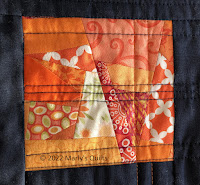My goal for this month was to finish the Kawandi quilt I started at the end of February. And I did! Here it is:
It is just 38 x 38 cm, and made from a bag of scraps from other members of the Dutch Modern Quilt Guild. The rules of the challenge were to use scraps from the bag to make something and to only use two fabrics from your own stash. Apart from the backing and wadding I only used one fabric - the purple frame and the corners to the centrepiece; all the rest was from the bag.
I used Aurifil no. 12 cotton throughout, except for the French knots in the centrepiece which are two strands of DMC stranded cotton.
 |
| Centrepiece quilted with embroidery: stem stitch, running stitch and French knots. |
I posted earlier about this project: here and here . In the second of these posts I described the process.
Although the process is not difficult I found this slow going at the beginning. Not surprising as I had to find a way to anchor the side edges of the pieces as I added them, and the lines of stitching are obviously longer on the outside of the piece. This was intended as a sampler, a practice piece; I knew it wouldn't be perfect and yet I'm satisfied with the result. I learnt a lot in the making!
I am linking up to:
- One Monthly Goal Finish: https://www.elmstreetquilts.com/2022/03/OMGMarch22finish.html
- Peacock Party at Wendy's Quilts and More: https://wendysquiltsandmore.blogspot.com/2022/03/my-very-first-prairie-schooler-santa.html
Click on the link to see what others have been up to.
Happy sewing
Marly.














